Women can go bald, too. According to The American Academy of Dermatology, in the United States, approximately 30 million women are struggling with hair loss in comparison to the 50 million men also dealing with hair loss.
Dealing with hair loss can be detrimental to self-esteem. But for women, in particular, they suffer more, as society associates femininity with long and lustrous hair. It’s an embarrassing reality that women have reported has taken an emotional toll on them.
Dr.UGraft Zeus ™ offers a type of hair transplant procedure for women which doesn’t necessarily require shaving the entire scalp for extracting FUE donor grafts.
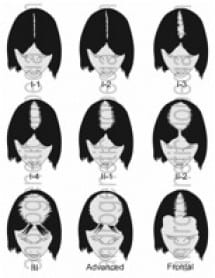
Causes Of Hair Loss In Women
When men lose hair, it’s almost always due to a genetic inheritance, known as androgenic baldness in medical terms. This phenomenon is also known as male patterned baldness. For this reason, hair loss in most men typically requires no further diagnostic work and, in most cases, doctors can perform treatments including hair transplantation without further medical study.
In FPB hair loss occurs at the top and crown of the head. Another striking difference between MPB and FPB is that the way a woman loses her hair is in a different pattern than a man. As the thinning occurs it widens at the center of the hair part, not affecting the front of the hair
By contrast, there are a variety of factors that could be responsible for the loss of hair in women, many of which are treatable or reversible. Because of this, treating female hair loss begins with the search for treatable secondary causes. If a doctor identifies a treatable cause (outside of genetic causes), proper care can potentially reverse or halt hair loss.
In an effort to maintain their allure, women experiencing significant hair loss often try to conceal thinning with wigs and hairpieces.
Reversible/treatable causes of hair loss in women can include:
- Pregnancy
- Stress
- Untreated hypothyroidism
- Sleep deprivation
- Medication
- Folic acid deficiency
- Vitamin D deficiency, which can lead to anemia
Additionally, several medical conditions can also result in female hair loss. As with other causes, proper medical care can treat hair loss and restore hair:
- Telogen effluvium – A condition that causes temporary hair loss, though it may have far more devastating effects than ordinary causes of short-term thinning. Women who battle with the disorder experience a disruption in the telogen phase, the period in which hair does not grow. The phase usually has a short duration, but extended intervals cause noticeable thinning.
- Alopecia areata – A condition in which the immune system attacks hair follicles. The scalp is subject to so much pressure that follicles diminish and hair growth stops. The direct cause of alopecia areata is unknown but its effects are devastating.
- Traction alopecia – common among African American women, traction alopecia is hair loss caused by hairstyles that call for constant pulling. The stress placed on the hair follicles near the edge of the scalp leads to thinning.
- Lupus – Also recognized as Systemic Lupus Erythematosus, the disorder causes the immune system to attack healthy tissue, which leads to dysfunction in various areas of the body. The brain, joints, kidneys, and skin are a few places where the effects of lupus are evident. Hair loss is another devastating result of the illness.
- Trichotillomania – A disorder that causes women to feel the need to pluck hairs from their roots. Eyelashes, eyebrows, and hair from the scalp are three areas that are most affected by the disorder.
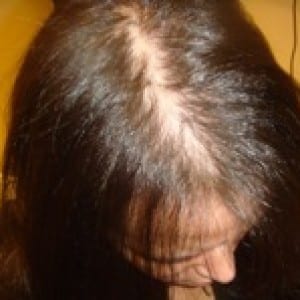
Dr. UGraft Zeus™ Female FUE Hair Transplant Treats Genetic Hair Loss
So who exactly can qualify for a female hair transplant? Some, but not all women, who suffer from androgenic alopecia will continue to have sufficient quantities of intact hair. These can then serve as donor grafts for a hair transplant procedure.
Although there are treatment products to help aid in hair loss for women there is a more permanent and reliable solution, the Dr UGraft Zeus procedure for Follicular Unit Extraction.
The surgery involves taking follicles from areas on the scalp that still experience growth and transferring them to areas where hair has thinned. Doctors favor the FUE technique over traditional surgical methods for several reasons.
First, the procedure is minimally invasive. A female FUE transplant makes small incisions that heal with time rather than implementing large cuts, as with strip harvesting, that leave permanent scars. Furthermore, the recovery time is rapid. Patients needn’t take extra time off from work since the FUE procedure does not involve stitching. Even better, the procedure rarely leaves any cosmetically significant scarring. Though a surgeon does make incisions in an FUE procedure, they are made in the form of pokes that heal themselves within days of surgery. At most, patients can expect to see little dots that are otherwise unnoticeable to the average observer after surgery.
Dr. Sanusi Umar has years of experience as a medical professional, specializing in hair restoration. He has led in the field and set the standard for hair transplants with the invention of his Dr.UGraft Zeus ™hair restoration method. The device can extract hair from any place on the body for more efficient sessions. The Dr.UGraft Zeus ™ technological system is poised to take the field of hair transplantation for women to the next level.
Considerations Before Undergoing Female Hair Transplant Surgery
When considering hair transplants for females, it often surprises women that the donor areas, which oftentimes come from the back and sides of the scalp, need to be shaved prior to surgery. The doctors need to shorten the hair in these areas in order to properly extract and place the transplanted follicles into the balding spots. Doctors shorten hair in these areas prior to surgery, to properly extract and place the transplanted follicles in balding spots.
The idea of unevenly cut hair, even as a temporary style, does make some women nervous. Dr. Umar recommends a specific treatment for these patients:
- Hair is shaved horizontally from the donor areas.
- Hair that is not in the donor areas is preserved so that it covers short spots.
Following hair transplant surgery for women, the donor area heals within a matter of weeks, after which hair may be styled as usual. New hair growth begins about a month after surgery.
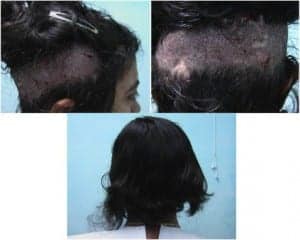
However, the advanced technology of Dr.UGraft Zeus™ offers women the option of long hair FUE. Dr.U uses this technology in combination with a special proprietary approach that he developed. Instead of shaving the sides or back of the head, his technique involves shaving a horizontal zone on the scalp covered by the patient’s own hair. This helps women keep the signs of their hair transplant (i.e. donor wounds and scars) private.
So that then resume their normal day-to-day activities immediately afterwards. In other words, they can undergo an FUE hair transplant without having to shave their head, at all in certain cases. Because Dr.UGraft Zeus™ is designed with cutting-edge settings engineered specifically for long hair, the final FUE wounds are hidden by the patient’s normal, everyday hair style.
The patient’s photo above depicts a uniquely novel approach to long hair FUE which was exclusively developed by Dr.U. In this particular instance, he was able to keep the patient’s donor area (i.e. where hair follicle grafts are extracted) completely hidden by the usual length of her hair.
In some cases patients, shaving may be completely unnecessary due to a proprietary non-rotary punch driven by the Dr.UGraft Zeus ™ system. In these instances, Dr.U removes both the follicle and the uncut, long hair. The punch uses a set of double prongs to excise the skin tissue around the graft. This avoids the inconvenient issue of hair tangling and smoothly expedites the extraction phase of the procedure.
Dr.UGraft Zeus™ FUE Female Hair Transplant Before and After
The following patient decided to invest in a female hair transplant after developing traction alopecia. Wearing a tight ponytail, nearly everyday led to Intense and constant pulling, followed by hair loss. Both her temples suffered from noticeable thinning which led to her decision to undergo a Dr.UGraft Zeus ™ hair transplant procedure for women.
-
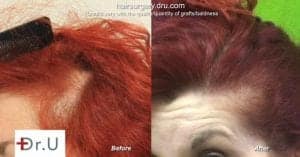
Female hair transplant results: Constant pulling caused by tight ponytails and braids can lead to hair loss. Body Hair Transplant (BHT) with Dr.UGraft can reverse the effects.*
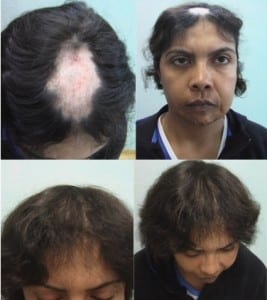
-
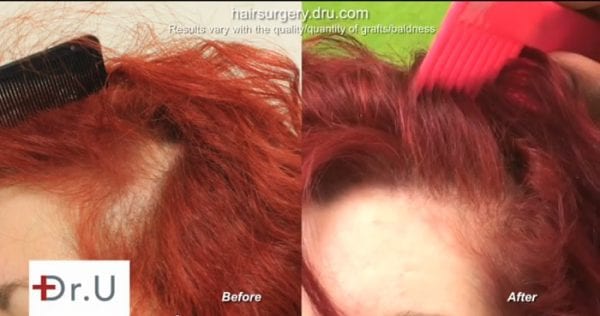
Female hair restoration before and after: The effects of traction alopecia can be reversed with Follicular Unit Extraction, often abbreviated to female FUE hair transplant in women.*
Dr. Umar used his Dr.UGraft machine to carry out the Follicular Unit Extraction (FUE) method for hair restoration for this patient. He carefully extracted a donor pool of 200 grafts from an area of her head that experienced healthy growth. Dr. Umar then inserted the follicles into the bald sectors of the temple region.
The Dr.UGraft Zeus™ hair transplant for women reversed the effects of traction alopecia and the patient can now wear her hair in various styles. She loves to pull her hair up without worrying about the possibility of bald spots showing.
Dr.UGraft Zeus ™ FUE Female Hair Transplant Result In Video
The video below details more on female hair transplant before and after surgery.
Are you a woman considering a hair transplant procedure for hair loss? Click the button below to submit your photos and information to Dr.U himself.
Frequently Asked Questions -The Dr.UGraft Zeus™ Hair Transplant For Women
Can women get hair transplants?
Yes! Women suffering from female hair loss no longer need to do so in silence. Due to the invention of the Dr.UGraft Zeus™ procedure, women can restore their head of hair to its full beauty, regardless of the original cause of hair loss.
I have hair loss due to years of excessive hair bleaching or other trauma. Am I still eligible for a female FUE hair transplant?
Yes! Dr.UGraft Zeus™ treatment can address hair loss of any cause, and harvest follicles from anywhere on the body to restore hair. This versatility allows Dr. Umar to treat any case of baldness, regardless of cause or gender.
I have hair loss in other areas like my eyebrows or eyelashes… can the Dr.UGraft Zeus™ hair transplant for women treat those areas?
Absolutely! The versatility of Dr.UGraft Zeus™ also allows it to transplant hair follicles to even the most delicate areas, like the eyelashes or eyebrows. Dr. Umar often uses hair from the nape of the neck or legs to reconstruct the brow line or eyelashes.
What does recovery from Dr.UGraft Zeus™ female hair replacement procedure entail?
Dr.UGraft female FUE hair transplant requires only minimal local anesthesia, and patients remain conscious during the procedure. Afterword, the patient can return to normal life habits. Following the female hair replacement, patients will notice some scabbing or crusting at the transplant areas, usually in the form of tiny dots that slough off within a week. New hair growth takes about a month to begin and can take up to a year to reach full results.
How much does a female hair transplant cost?
The cost of hair transplants for women depends on the extensiveness of the hair loss and the number of grafts needed to restore hair. A free consultation with Dr. Umar to discuss desired results for women’s hair restoration can also include a price estimate prior to surgery.
Does hair transplant for girls differ from that of men?
Dr.UGraft Zeus™ is equipped to treat both men and women. Dr. Umar uses the same basic process in hair surgery for women as he does in men.
